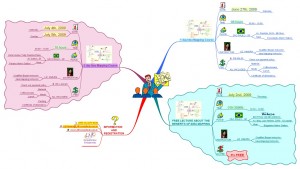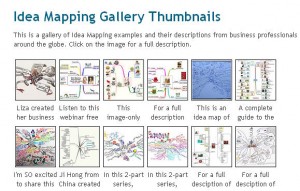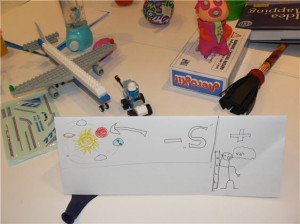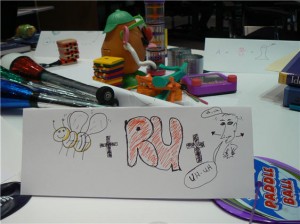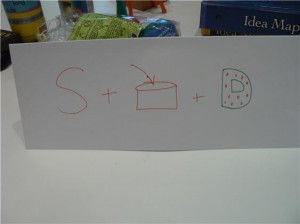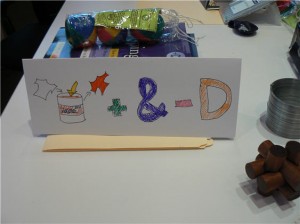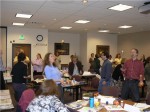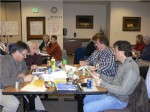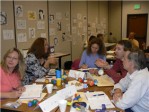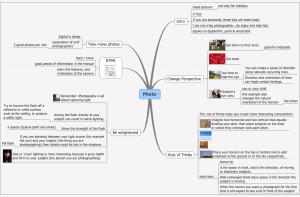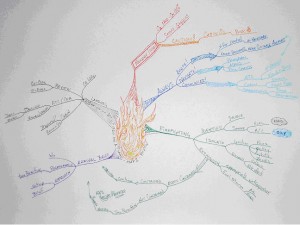An Idea Mapping Success Blogs Weblog
Glenn Stennes’s Portrait Drawing
18 Jun 2009 Author: Jamie Nast In: Certified Idea Mapping Instructors, Glenn Stennes, Idea Mapping Workshops, Portrait DrawingsGlenn Stennes is a CIMI (Certified Idea Mapping Instructor) who owns a consulting company in Macedonia. He went through the Idea Mapping Certification Course in April of 2008. As part of that workshop participants are given a brief set of instructions and a technique to recreate a portrait of a human face. To learn more about the purpose of this activity see the first portrait drawing that went up on this blog in June 2007.
A few weeks ago, Glenn ran across his finished portrait and sent me a jpg of it. On the left side is the original portrait he chose to draw and on the right is his finished version. Pretty impressive, eh?
Social Networking – Part One
16 Jun 2009 Author: Jamie Nast In: Social NetworkingI was first introduced to the world of social networking three years ago by the owner of Urban Verve — the company that designed my website and this blog. I started out slowly by learning to digg, got linked in, built a squidoo lens, and put idea maps and workshop photos into flickr. My digg submissions bookmark various pages of interest. Like many of you, I joined LinkedIn and now have nearly 200 connections. I followed that by building my first Idea Mapping Squidoo Lens (I now have a second lens), and finished phase 1 by creating two photo streams in Flicker. The Idea Mapping Photo Stream currently has 99 Idea Mapping Examples (and growing), and the Idea Mapping Workshop Photo Stream has 46 photos from companies like Boeing, OTPP, CPPIB, Larimer County Government, Ford, (and growing) and many others.
For those of you who are struggling with the learning curve of social networking, find a friend who is saavy in this area and learn from them. I’m still stuggling in many of these areas and will share more about that in another posting.
Idea Mapping in Brazil – Summer 2009
14 Jun 2009 Author: Jamie Nast In: Idea Mapping Example, Idea Mapping Workshops, Mind Mapping ExamplesLiz Kimura is the only Certified Idea Mapping Instructor in South America. She has three upcoming events that you won’t want to miss if you live in and around Brazil. Liz is one of the best Mind Mapping and Idea Mapping Instructors in the world, and her participants are more successful as a result of attending her workshops. I’ve spent a week with Liz on two separate occasions several years apart. I highly recommend her as a facilitator. Following is both an Idea Map of these events and a description. Details are also listed on her blog.
On June 27, 2009 from 9am – 6pm Liz will teach a one-day Idea Mapping Course in Sao Paulo for R$ 800,00 per person. Materials, lunch, coffee break, and a certificate of attendance is included in the fee.
On July 2, 2009 from 2:30pm – 4pm Liz will give a FREE lecture in Sao Paulo on the Benefits of Idea Mapping.
On July 4-5, 2009 from 9am – 6pm Liz will teach the two-day Idea Mapping Course in Sao Paulo for R$ 1.430,00 per person. Materials, lunch, coffee break, parking, and a certificate of attendance is included in the fee.
If you would like to have Liz teach at your organization or register for any of these events, contact Liz via email at Liz(at)IdeaMappingSuccess(dot)com or call her offices at (+55-11) 3271-9336. Visit her website or follow her on Twitter.
Planning for Medical Residency – Idea Map #156
11 Jun 2009 Author: Jamie Nast In: Idea Mapping ExampleMeet Ashay Gharat. He is a process expert and helps organizations become more successful by increasing revenue and reducing cost through effective program and service delivery management. He focuses on leading organizational change by defining the road map for change and actually following through the execution. Currently he services pharma clients including Novartis Pharmaceuticals. He is part of the management team at Elangeni Consulting.
- First it solves a real concern.
- It breaks the mind mapping laws and truly becomes an idea map that fits his unique purpose. (I’ve discussed this issue on my newest Squidoo Lens.)
- The time line in the map is creative and clever.
- I like the stethoscope around Dr. Rashmi’s neck in the central image.
- I love the fact that the celebration is included!
Idea Mapping Website Becomes an Authority Site in Google
8 Jun 2009 Author: Jamie Nast In: Web StatisticsI find the whole online world a fascinating space. My Idea Mapping Website went up 3 years ago this month. At that time I knew NOTHING about creating a website and hadn’t heard of blogging. With the guidance of Cornel Ivanescu (Founder of Urban Verve — ranked one of the top 10 web design companies in the Midwest), the amount of traffic coming to my site has soared in the last 3 years. I’ll give you some examples:
In June of 2006 (first month of existence) we had 834 unique visitors view 10,362 pages within the site. We had 49,553 hits and 145 referrers that month. In June of 2007 I had 4,256 unique visitors view 11,514 pages within the site. We had 223,621 hits and 751 referrers.
In June of 2008 we had 16,627 unique visitors view 66,434 pages within the site. We had 365,432 hits and 1,321 referrers. We closed out 2008 with over 1/4 of a million visitors. Last month we had 44,748 unique visitors view 159,061 pages within the site. We had 599,087 hits and 2,902 referrers. We are on track for over 1/2 of a million visitors this year!
Last month Google made the Idea Mapping Website an authority site. This is an honor. I’ve learned so much in the last 3 years and I want to personally thank Cornel for being such an important business partner in this area. In today’s world, if you don’t have a presence on the internet, you won’t be found. I also want to thank you — the readers of this blog, the website visitors, and the many, many workshop participants over the years. Your willingness to share idea maps, mind maps, portraits, and suggestions is what makes this community valuable to all.
If you want some expert assistance on developing a blog or a website, I encourage you to contact Cornel by visiting his site – UrbanVerve
CPPIB (Canada Pension Plan Investment Board) – Part 1
5 Jun 2009 Author: Jamie Nast In: Idea Mapping Workshops, Name Tent ActivityIn April 2009 I posted about the first Idea Mapping Workshop for CPP Investment Board in Toronto, and shared an idea map that Jason Koulouras (Director of Data Services) created. I would now like to share a few more details about that course.
As you have seen in previous postings, each participant is asked to create a name tent similar to the game “Concentration”. Here are 5 name tents for you to see if you can guess the names of the participants. I will announce your name if you guess any of the names correctly and link back to your blog and/or website!
Game On!
P.S. If you want to see more idea maps and workshop photos my Flickr Photostream currently has 191 photos with over 11,400 views.
Why Right-Brainers Will Rule the Future
4 Jun 2009 Author: Jamie Nast In: Articles, Book Reviews, Idea Mapping Example, InterviewsI am a huge fan of Daniel Pink who wrote the book, “A Whole New Mind“. You can even see a detailed Idea Map I created of his book.
I recently received an email from a long-time client and friend who works for a large automotive company in southeastern Michigan. She forwarded a link to an interview Oprah recently did with Daniel Pink where they discuss the creative class, the sourcing of technology development, and ways to adapt to the “conceptual” age. If you haven’t read Daniel’s book, I highly recommend it.
Workshop or Seminar or Training or Course?
3 Jun 2009 Author: Jamie Nast In: Idea Mapping Certification Workshops, Idea Mapping WorkshopsBack in the 1990’s I taught my 2-day workshop under several names: Mind Mapping Course, Mind Matters Workshop, Mind Mapping Seminar, Radiant Learning Class, Mind Mapping Workshop, Think, Learn and Create Course, Mind Mapping Training, and probably a few others that have since slipped my mind. Finally the title Mind Mapping Seminar evolved into Idea Mapping: A Learning Workshop, so that the title gave a broader description of the contents of the learning experience.
I think that the term Workshop best describes this kind of training because it is a highly interactive, fun, enjoyable, crazy, experiential way to teach skills to others that will make them more successful. See just a few of these crazy workshop photos below from thousands I’ve taken over the past 17 years:
When I hear the word Seminar I think: business attire, boring, listening to lectures, PowerPoint slides, rows of chairs with no tables to write on, little involvement, and certainly without fun and toys. I’m exaggerating a bit, but that’s why I think that “Mind Mapping Seminar” of past and now today’s “Idea Mapping: A Learning Workshop” is a better title.
Training feels like an old term to me. I picture leading a step by step set of directions similar to software training. Although participants are technically being trained, I don’t think the term belongs in the title.
Course is an interesting word. It reminds me of high school and college, and again less interactive. But I’ve found that it is also a culturally preferred word in some areas of Europe, Australia, New Zealand, and other parts of the world.
Because I’ve had a couple people lovingly challenge me on terminology, I thought I’d throw the question out to you. Any thoughts?
Idea Map #155 – Photography Tips
28 May 2009 Author: Jamie Nast In: Idea Mapping Example, Idea Mapping Software, Idea Mapping Workshops, Mind Mapping Examples, Mind Mapping Software, MindManagerYesterday I returned from teaching an Idea Mapping Workshop at Ontario Teachers’ Pension Plan (OTPP) in Toronto. One of the participants was Dan Houle who is the VP of Investment Operations. He has been and avid mind mapper and user of MindManager since 2005. He estimates that he has easily created over 650 maps using Mindjet’s software and he shared several of those with the class.
This is the first of his examples that I will share until we make sure any proprietary information is removed from his others. For Dan’s fellow photographers, I think you will enjoy his tips. As usual, email me if you want to have this idea map in the original MindManager format. jamie(at)ideamappingsuccess(dot)com
Fire in the Plane – Revised Idea Map #154
21 May 2009 Author: Jamie Nast In: Idea Mapping Example, Mind Mapping ExamplesOn September 4, 2007 I first introduced you to Michael Panebianco who is a seasoned airline captain. His infamous “Fire in the Plane” idea map was one of many emergency procedures he has mapped in order to commit the responses to memory. This is a revised idea map that he created after actually experiencing a fire during one of his flights earlier this year. I’ll let him tell the story in his own words.
Idea Mapping Blog
The purpose of this blog is to share idea mapping examples and related learning from my Idea Mapping, Memory, Speed Reading, and Certification Workshops. This blog is dedicated to my Certified Idea Mapping Instructors, my clients, Mind Mapping and Idea Mapping practitioners around the globe.

![[Ask]](http://ideamapping.ideamappingsuccess.com/IdeaMappingBlogs/wp-content/plugins/bookmarkify/ask.png)
![[del.icio.us]](http://ideamapping.ideamappingsuccess.com/IdeaMappingBlogs/wp-content/plugins/bookmarkify/delicious.png)
![[Digg]](http://ideamapping.ideamappingsuccess.com/IdeaMappingBlogs/wp-content/plugins/bookmarkify/digg.png)
![[Facebook]](http://ideamapping.ideamappingsuccess.com/IdeaMappingBlogs/wp-content/plugins/bookmarkify/facebook.png)
![[Google]](http://ideamapping.ideamappingsuccess.com/IdeaMappingBlogs/wp-content/plugins/bookmarkify/google.png)
![[MySpace]](http://ideamapping.ideamappingsuccess.com/IdeaMappingBlogs/wp-content/plugins/bookmarkify/myspace.png)
![[Slashdot]](http://ideamapping.ideamappingsuccess.com/IdeaMappingBlogs/wp-content/plugins/bookmarkify/slashdot.png)
![[Sphinn]](http://ideamapping.ideamappingsuccess.com/IdeaMappingBlogs/wp-content/plugins/bookmarkify/sphinn.png)
![[StumbleUpon]](http://ideamapping.ideamappingsuccess.com/IdeaMappingBlogs/wp-content/plugins/bookmarkify/stumbleupon.png)
![[Technorati]](http://ideamapping.ideamappingsuccess.com/IdeaMappingBlogs/wp-content/plugins/bookmarkify/technorati.png)
![[ThisNext]](http://ideamapping.ideamappingsuccess.com/IdeaMappingBlogs/wp-content/plugins/bookmarkify/thisnext.png)
![[Twitter]](http://ideamapping.ideamappingsuccess.com/IdeaMappingBlogs/wp-content/plugins/bookmarkify/twitter.png)
![[Webride]](http://ideamapping.ideamappingsuccess.com/IdeaMappingBlogs/wp-content/plugins/bookmarkify/webride.png)
![[Email]](http://ideamapping.ideamappingsuccess.com/IdeaMappingBlogs/wp-content/plugins/bookmarkify/email.png)

